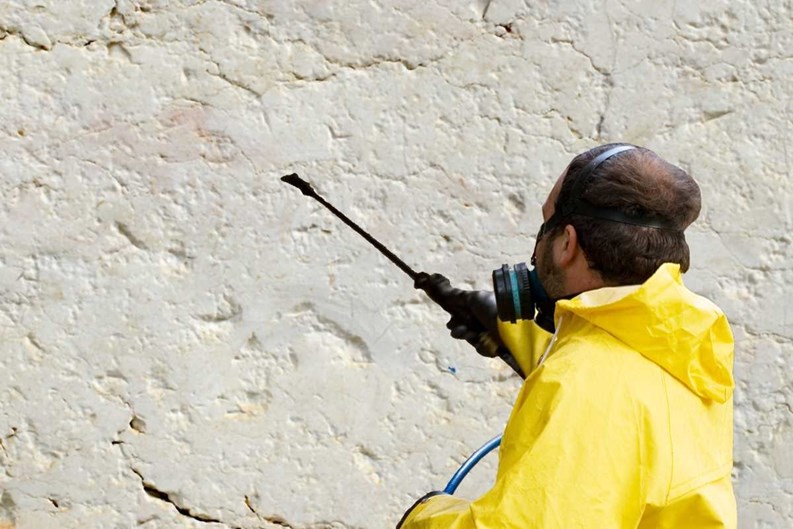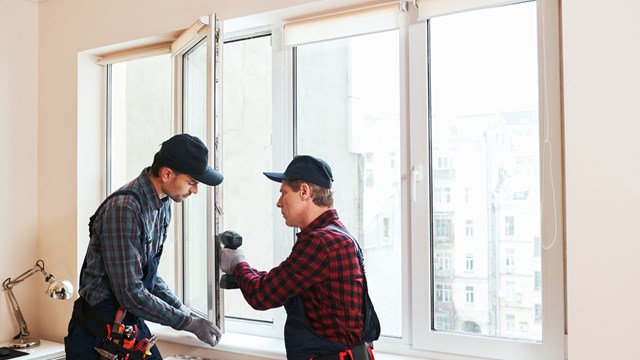Living in New Jersey can be something of a dirty job. And because of the task of cleaning off months (or years) of accumulated grime and dirt from the exterior of a building takes much more than a scrub-brush and a bottle of Windex; it requires professional help. The work is not just a labor-intensive job, it also calls for extensive knowledge of building materials, cleaning products, and cleaning methods.
Removing Mess
For residents of condos, townhomes and co-ops, knowing when, how and why—or why not —to have the exterior of their building cleaned could be a matter of dollars and cents, but it also should be about what makes common sense. Most associations would find it unnecessary to clean their building’s entire exterior each month, but some might want it done semi-annually, while others could allow the façade to darken for years before tending to it. It all really depends upon a community’s perceptions, needs, and budget.
Knowing the causes of exterior dirt and the cleaning methods used to deal with it can enable residents to take a realistic approach to the problem of keeping their building’s façade looking spiffy. It’s hard to say what creates the most stains and grime on buildings: air pollution, soot from oil-burning furnaces, or car exhaust. Facades are soiled by atmospheric conditions like air pollution and acid rain and the buildup of dirt on a building over time can dull architectural details and lessen the beauty of the structure.
“The most common types of stain and grime found on New Jersey buildings are algae,” says John Doherty, president of Garden State Powerwash in Manalpan. “So the cause is environmental. You see it more on the north side of buildings because that gets the least amount of sun.”
Colm Fidgeon, president of Precision Powerwash in Somerdale agrees with Doherty that environmental pollutants is the number one source of most grime and grit on New Jersey buildings. “Mother Nature is the problem,” he says. “It causes all of the mold and algae, especially on roofs. I see lots of algae, the black streaks on New Jersey rooftops.”
“Everything depends on where your building is located,” says Dave Scaturro, sales and marketing director for Alpine Painting & Sandblasting Contractors in Paterson. “For example if you are located in the woods and there's a lot of trees and heavy growth around, you're going to get a lot of mold and mildew. If you have a lot of steady rain and you don't have the proper eaves protecting your building then you are much more likely to get that green, discolored look on the siding or trim of your building. If you are in the city and you get lots of cars driving by you're going to get a lot of carbon staining. We see more mold and mildew than carbon but it's completely dependent on the location of the building.”
According to experts, graffiti is a particular kind of pollution that can be removed or covered in ways that are specific to it. Generally, a pressure-washer is used in conjunction with chemicals to remove the paint and marker scrawl of graffiti on the exterior of a building. Graffiti may also be removed with specially-designed restoration paint strippers.
Aside from looking terrible, some long-term problems may be associated with letting dirt and grime accumulate on your building. That dirt can create a sealing barrier that won’t allow the building exterior to “breathe,” and thus, cause problems such as water retention. Also, calcium and sulfates left on a building facade create acidic conditions and salts which can penetrate and cause deterioration to the masonry and underlying materials.
“Never mind the aesthetics of it any number of maintenance issues can occur if you let dirt and grime accumulate on a building,” says Fidgeon. “It will be that much harder to clean. When a building is clean it adds to curb appeal. People want to live in a clean building. When people are walking around a building and it's getting washed and cleaned it's a good feeling. If there is a stain people will pay more attention to it.”
“For different types of siding like stucco, dirt and grime can penetrate through siding and allow a pathway for water to come in,” warns Doherty. “Dirt will also oxidize the siding and take away the pigment so the color will fade out sooner.”
Other long-term problems of grime and staining of a building’s exterior include a less-favorable perception by residents and potential buyers of the state of the property. Curb appeal is a real factor which can have a major impact on a person’s decision to buy or not buy an apartment or condo unit in a building. A structure with a clean, sparkling exterior, bereft of black grime or copper stains from long untended decorative cornices, will be more appealing to both residents who live in it, and also those considering buying into it. So, strictly speaking, not caring for a residential building’s exterior is like ignoring the value of each unit in that building, since ignoring the exterior will undoubtedly detract from values of the interior.
Cleaning Frequently
How often a building’s exterior should be cleaned varies from place to place, based upon factors including how long it’s been since the job was done, how well the job was done previously, what the façade is made of, the building’s budget and other considerations. For some communities, an exterior cleaning can be done in stages, with just the front façade professionally cleaned with any regularity and the entire exterior getting the once-over less frequently.
Periodic cleaning of the building façade is recommended by professionals and will vary based on factors such as location of the building, exposure to atmospheric contaminants such as exhaust and other forms of pollutants along with acid rain, as well as the type of construction. Limestone, granite, brick and concrete are cleaned in different ways, depending upon the severity of grime and the cleaning methods chosen by the contractor.
Usually, contractors do an exterior cleaning from the top of the building to the ground floor. Sometimes the building’s board just asks for the front façade of the place to be cleaned, and that the other three sides of the exterior be left alone.
The frequency of cleanings also varies from brick to limestone to concrete. Softer materials such as limestone and some types of molded bricks can require more gentle cleaning methods, and contractors may forego restoration cleaners completely in favor of pure water soaking. This method involves the contractor attaching a soaking system to the building’s façade at the rooftop, then allowing the soaker to wet the façade of the building continuously in a very low-pressure spray for a day. After that, grime is easily power-washed off of the building’s exterior. Vinyl siding is also periodically pressure washed to get rid of the accumulated dirt and grime.
“I recommend to building managers to have their buildings cleaned every three years,” says Doherty. “It maintains property value. No one wants to see dirt on a building, residents don't want to see it and potential owners definitely don't want to see it.”
“Everything depends on the budget,” says Fidgeon. “We give our cleanings a three-year warranty.”
Generally speaking, contractors across the board use pretty much the same methods to clean buildings. Depending upon the job, varying combinations of high and low pressure water, detergents, strippers and acidic cleaners are used with spray bars and brushing to achieve the desired effect. But you cannot tell how it will all turn out unless you test your method, first.
To keep at least the ground floor of the building’s exterior looking its best between professional scrubbings, the staff should power-wash the exterior at least once a month. Some buildings have such a quick cleaning done more often.
The processes and products used to clean building exteriors have changed a lot over the years, and now the chemicals used are far less caustic than in years past. While cleaning chemicals in the past would leave streaks on windows they came into contact with, newer chemicals will not.
“We have our own soap that’s environmentally friendly and we've been using that for over 22 years, and we've never lost a plant with it,” says Fidgeon. “The green movement has affected cleaning products, it's more costly but worth it. The green movement has been great and we are a part of it.”
“In the last five years the advances in the chemistry of cleaning products has been phenomenal,” says Doherty. “It allows us to remove different bits of growth and grime from buildings without the pressure like we used to. The products that are available now helps us break the surface tension and release dirt and grime from the siding without having to manually grasp them with the water.”
Industry experts contacted for this article all agreed that picking the right contractor is one of the most important aspects of undertaking an exterior cleaning of a residential building. A board should truly vet the contractor before hiring him, and make sure the company has done the same kind of work for other clients. Then the board should also check how well that work was done.
“The green movement has had a huge impact on our industry,” says Scaturro. “Everyone is much more conscious of the environment and about the health and safety of the employees and residents. There's less fumes, paint odors and hazardous materials within paint and cleaning agents now. The technology has changed dramatically. For instance, you can recycle water that we use to clean buildings. Technology has come a long way and cleaning products have come a long way. So it's a good idea to align yourself with a contractor who utilizes these technologies.”
“Every Tom, Dick and Harry seems to get involved in exterior cleaning,” says Fidgeon. “So it's important to choose a professional licensed contractor. And you shouldn't always go for the lowest bid. You get what you pay for.”
“I think the most important thing that people should know about exterior cleaning is that the advances in our industry of cleaning buildings is that sometimes pressure can be the enemy if not used correctly,” says Doherty. “There are professional cleaning products out there that do the work so you don't have to blast every square inch. And it's always best to have a professional do it.”
Finally, the board should check the contractor’s insurance papers for the work to be done on the building—or have the building’s attorney eyeball the papers—to ensure that the insurance covers everything that it should. If it doesn’t and things go wrong with the job, the building’s residents could be left holding the bag.
Jonathan Barnes is a freelance writer and regular contributor to The New Jersey Cooperator. Staff writer Christy Smith-Sloman contributed to this article.







Leave a Comment